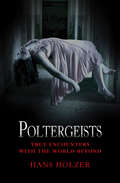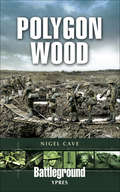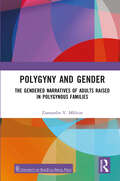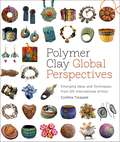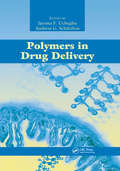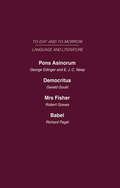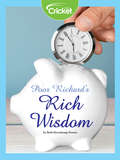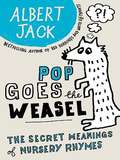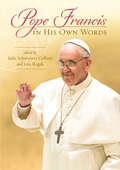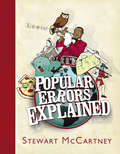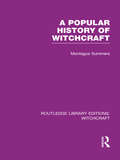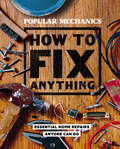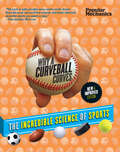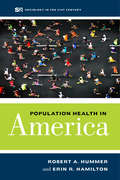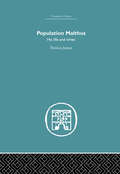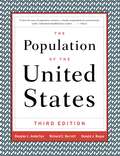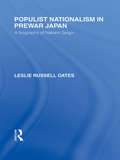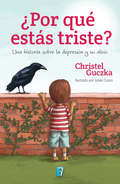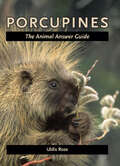- Table View
- List View
Polity and Constitution Part-4 - IAS Competitive Exam
by Vision IasUpdated Value Additional Material for 2020 IAS examination on the topic Polity and Constitution - Part 4
Poltergeists: True Encounters With The World Beyond (True Encounters with the World Beyond #8)
by Hans HolzerParanormal expert Hanz Holzer investigates some of the most famous poltergeists in history Poltergeist is a German term that translates simply to “noisy ghost.” One of the main characteristics of a poltergeist is its high level of activity; it often manifests itself by moving or even throwing objects. Professor Hans Holzer reexamines these most menacing of hauntings, including the famous case of the Bell Witch of Tennessee, a nineteenth-century spirit, and the Millbrae Poltergeist, which crashes around a suburban home.
Polygon Wood (Battleground Ypres)
by Nigel CaveThis wood featured significantly in the First and Third Battles of Ypres and was the scene of numerous deeds of heroism, such as that which won young Lieutenant-Colonel Philip Bent the VC. The courage of individuals and units from Britain and Australia is described in this latest edition to the series covering Ypres.
Polygyny and Gender: The Gendered Narratives of Adults Raised in Polygynous Families
by Zamambo V. MkhizeThe people of Africa have contrasting perspectives on gender, feminism, and the family from their Western counterparts. Similarly, social structures like, religion, capitalism and the law require a context-specific application to polygyny. This book examines the construction of gender identity in adults raised in Zulu polygynous families in the Hammarsdale area in KwaZulu-Natal, South Africa. It highlights the complexities of gender identities as participants negotiate between modern, constitutional, and individual freedoms and patriarchal, cultural, and communal customs and traditions. The themes also point towards the argument between individuality and collectivism in the creation of gender identity within polygynous families in Zulu culture. The South African Constitution guarantees gender equality and individual rights and freedoms for its citizens, yet customary law practices, like polygyny, appear to contravene these principles. The participants reveal that although women and men experience different consequences, they cite similar prevalent factors like gender role socialisation, naming practices and the doctrine of seniority, influencing their gender identity construction. Print edition not for sale in Sub Saharan Africa.
Polymer Clay Global Perspectives: Emerging Ideas and Techniques from 125 International Artists
by Cynthia TinappleExplore the World--in Polymer Clay!Polymer artists are connected like never before. As the acclaimed curator of the popular blog PolymerClayDaily.com, Cynthia Tinapple brings together 115 diverse artists from around the world to showcase the work of this new international community. Polymer Clay Global Perspectives invites you to explore the trends and cutting-edge styles that are influencing the future of this medium. In this masterful collection, you'll find: · Tips to create meaningful art that reflects your personality and vision· Behind-the-scenes profiles of 13 innovative artists in their studios· Step-by-step projects by contributors who share their signature methods, such as mokume gane,extruded canes, and adapted glass-blowing techniques· Galleries showcasing the best of the best polymer work in jewelry, miniatures, sculpture, and much moreWith artists including Kim Korringa, Shay Aaron, and Fabiola Perez offering their expertise, you'll find endless inspiration to take your art to the next level. Begin your own journey through the new landscape of contemporary polymer. A world of possibilities awaits.
Polymer Clay Master Class: Exploring Process, Technique, and Collaboration with 11 Master Artists
by Judy Belcher Tamara HonamanLearn the Signature Techniques of Top Polymer Clay ArtistsPolymer Clay Master Class offers you a close-up look at the creative processes of eleven acclaimed polymer clay artists as they share their expertise with one another and you. Judy Belcher and Tamara Honaman bring together these talented artists for the first time, offering their individual techniques and then documenting how they inspire and challenge one another in the creation of collaborative pieces. In five lessons with sixteen guided projects, you will gain an understanding of the polymer clay skills you've always wanted to master, such as:* Creating with sculpture, canework, and imitative techniques* Altering the surface with carving, transfers, imprint, and silk screening* Incorporating mixed media, such as metal, wood, and fiber* Designing using cold connections, hollow and lightweight forms, kinetic construction, and jewelry-finishing techniques* Pushing the boundaries of the Skinner Blend technique* Collaborating with fellow artists to open up new creative possibilitiesWith contributors including Leslie Blackford, Cynthia Tinapple, Lindly Haunani, Sarah Shriver, and many others, you have a front-row seat to the world of innovative polymer clay art. Challenge your assumptions about methods, style, and collaboration, and get ready to start on your own creative journey. Also available as an ebook
Polymers in Drug Delivery
by Ijeoma F. Uchegbu Andreas G. SchatzleinTogether, the nano explosion and the genomic revolution are ushering in a new frontier in drug delivery. In recent years we've seen how polymers can play a crucial role in controlling the rate of drug release, enhancing solubility and uptake, and limiting degradation and toxicity. In the very near future, they may well be used to deliver gene thera
Pons Asinorum, or the Future of Nonsense Democritus or the Future of Laughter Mrs Fisher or the Future of Humour, Babel, or the Past, Present and Future of Human Speech: Today and Tomorrow Volume Twenty-Two
by Edinger, Gould, Graves, PagetPons Asinorum Or The Future of Nonsense George Edinger and E J C Neep Originally published in 1929. "A most entertaining essay, rich in quotation from the old masters of clownship’s craft." Saturday Review The author maintains that true nonsense must be aimless humour – the humour that makes fun as opposed to the humour that makes fun of something. 88pp Democritus Or The Future of Laughter Gerald Gould Originally published in 1929. "Democritus is bound to be among the favourites of the series. Gould’s humour glances at history, morality, and humanity…wise and witty writing." Observer Democritus is intended to illustrate the prevailing fashion in laughter and on the basis of historical and philosophical principles to forecast the humour of the future. 90pp Mrs Fisher Or The Future of Humour Robert Graves Originally published in 1928 "Mr Graves is the best man who could have been chosen to write on this subject." Daily Express "…perfectly irresponsible, as a joker should be." The Times This volume analyzes humour with a solemnity which becomes almost nightmarish. 90pp Babel Or the Past, Present and Future of Human Speech Richard Paget Originally published in 1930. "…stimulating and absorbing." Journal of Education This volume discusses human speech and treats it as a growth which must be tamed if it is to fulfil its highest purpose as a symbolism for human thought. 86pp
Poor Richard's Almanack
by Benjamin FranklinBenjamin Franklin's classic book is full of timeless, thought-provoking insights that are as valuable today as they were over two centuries ago. With more than 700 pithy proverbs, Franklin lays out the rules everyone should live by and offers advice on such subjects as money, friendship, marriage, ethics, and human nature. They range from the famous "A penny saved is a penny earned" to the lesser-known but equally practical "When the wine enters, out goes the truth." Other truisms like "Fish and visitors stink after three days" combine sharp wit with wisdom.
Poor Richard's Almanack
by Benjamin FranklinBenjamin Franklin's classic book is full of timeless, thought-provoking insights that are as valuable today as they were over two centuries ago. With more than 700 pithy proverbs, Franklin lays out the rules everyone should live by and offers advice on such subjects as money, friendship, marriage, ethics, and human nature. They range from the famous "A penny saved is a penny earned" to the lesser-known but equally practical "When the wine enters, out goes the truth". Other truisms like "Fish and visitors stink after three days" combine sharp wit with wisdom. Paul Volcker's new introduction offers a fascinating perspective on Franklin's beloved work.
Poor Richard's Almanack (Barnes and Noble Digital Library)
by Benjamin Franklin Paul A. VolckerBenjamin Franklin's classic book is full of timeless, thought-provoking insights that are as valuable today as they were over two centuries ago. With more than 700 pithy proverbs, Franklin lays out the rules everyone should live by and offers advice on such subjects as money, friendship, marriage, ethics, and human nature. They range from the famous "A penny saved is a penny earned" to the lesser-known but equally practical "When the wine enters, out goes the truth." Other truisms like "Fish and visitors stink after three days" combine sharp wit with wisdom. Paul Volcker's new introduction offers a fascinating perspective on Franklin's beloved work.
Poor Richard's Rich Wisdom
by Beth Haverkamp PowersIn Colonial America, many people owned two books: a bible and Poor Richard's Almanack, one of Ben Franklin's many inventions. Franklin included calendars, tidal charts, and riddles in his famous publication.
Pop Goes the Weasel: The Secret Meanings of Nursery Rhymes
by Albert JackFrom the international bestselling author of Red Herrings and White Elephants—a curious guide to the hidden histories of classic nursery rhymes.Who was Mary Quite Contrary, or Georgie Porgie? How could Hey Diddle Diddle offer an essential astronomy lesson? Do Jack and Jill actually represent the execution of Louis XVI and Marie Antoinette? And if Ring Around the Rosie isn’t about the plague, then what is it really about? This book is a quirky, curious, and sometimes sordid look at the truth behind popular nursery rhymes that uncovers the strange tales that inspired them—from Viking raids to political insurrection to smuggling slaves to freedom.Read Albert Jack's posts on the Penguin Blog.
Pope Francis in His Own Words
by Julie Schwietert Collazo and Lisa RogakThe moment the identity of the newly elected 266th pontiff was revealed, it was clear to the thousands gathered in St. Peter’s Square, and to the watching world, that this pope was different in fascinating and exciting ways — the first from Latin America, the first Jesuit, and the first to take the name Francis, in honor of St. Francis of Assisi. When Pope Francis, formerly Cardinal Jorge Mario Bergoglio of Buenos Aires, spoke from the balcony of St. Peter’s Basilica, he greeted his audience colloquially: “Brothers and sisters, good evening.” He told a joke, commenting that his fellow cardinals had “gone to the ends of the earth” to find him. Then, downplaying his power and position, he proceeded not to bless the crowd but to ask them for their blessing: “I ask a favor of you,” he said, bowing humbly. “Let us make, in silence, this prayer: your prayer over me.” Francis has repeatedly foregone the fancy dress, lavish accommodations, and other luxuries of his position, emphasizing pastoral work with the sick and the poor and always seeking to empower the underdog (including his favorite soccer team in Buenos Aires — San Lorenzo). This revealing collection of his own words, gathered from sermons, interviews, and the Pope’s books, prompts understanding and insight into his way of being and believing — and inspires goodwill, love, and hope.
Popper-Arg Philosophers
by Anthony O'HearFirst Published in 1999. Routledge is an imprint of Taylor & Francis, an informa company.
Popular Errors Explained
by Stewart McCartneyIn 1841 John Timbs wrote a book called Popular Errors Explained. It went on - with Timbs' other great series 'Curiosities of ...' - to become one of the great popular books of the 19th century, running into many editions and selling hundreds of thousands of copies. Some say the popularity of his one hundred and fifty volumes led him to outsell a certain Mr Dickens.Stewart McCartney, under the Timb's title of Popular Errors Explained has created a new book, capturing the zeal and enthusiasm of the original, to be 'agreeable, by way of abstract and anecdote so as to become an advantageous and amusing guest at any intellectual fireside.' The book has completely new material - around 200 or so 'popular errors' from science and literature, history, sport, popular culture and so on. Each entry will have that eyebrow raising 'I didn't know that!' or 'Surely that cannot be true!' feel. Every one will explode a commonly held misbelief.
A Popular History of Witchcraft: Montague Summers (Routledge Library Editions: Witchcraft)
by Montague SummersThis is a comprehensive guide to the practices of witchcraft from their inception to the present day. Summers argues that all witchcraft is essentially the same, regardless of geographical location. He examines the practices of the cult in great detail, and its historical progression, within the context of the 1736 Repeal Act of George II.
Popular Mechanics How to Fix Anything: Essential Home Repairs Anyone Can Do
by Popular Mechanics&“. . . readers will count on Popular Mechanics&’ advice.&” —Booklist (starred review)For any home repair, big or small, homeowners can turn to this practical and portable reference. Got a squeaky floor or a rattling door?Is your grout a color you don&’t recognize anymore? From quick fixes like linking broken chains and patching drywall to more involved projects like replacing a fuel line and bleeding your brakes, Popular Mechanics How to Fix Anything is the handy and reliable go-to guide for the most common household problems offering a primer on plumbing, unexpected hacks like using a golf tee to fill a stripped screw hole, instructions for tuning up the garage door, and so much more. Throughout the book Roy Berendsohn, Popular Mechanics&’ senior home editor, answers questions about the trickiest fix-its, including how to deal with a recurring ceiling cracks or get rid of that stench from the kitchen sink.. And because it&’s organized room by room, from basement to bathroom to bedroom, it&’s simple to find the solution you need—so you won&’t have to hire someone else to do the job.
Popular Mechanics Why a Curveball Curves: The Incredible Science of Sports
by William Hayes Popular MechanicsAn absorbing and enlightening inside look at sports secrets—now in an updated and expanded edition! What makes an athlete successful? Why do some players excel? In this new, expanded edition, the experts at Popular Mechanics, along with top athletes, coaches, and sports journalists, explore the science behind everything from the perfect curveball and Phelpss kick to gene doping. Theres great new coverage on the recent doping scandals that rocked the Tour de France, as well as a new chapter on lacrosse, and the clear, understandable explanations come from people who really love their game. Youll even learn how to bend it like Beckham—or at least how Beckham did it. This book is for both the player and the fan, helping athletes become better prepared and giving enthusiasts a more complete appreciation of the subtle nuances of competition.
Population Health in America (Sociology in the Twenty-First Century #5)
by Robert A. Hummer Erin R. HamiltonIn this engaging and accessibly written book, Population Health in America weaves demographic data with social theory and research to help students understand health patterns and trends in the U.S. population. While life expectancy was estimated to be just 37 years in the United States in 1870, today it is more than twice as long, at over 78 years. Yet today, life expectancy in the U.S. lags behind almost all other wealthy countries. Within the U.S., there are substantial social inequalities in health and mortality: women live longer but less healthier lives than men; African Americans and Native Americans live far shorter lives than Asian Americans and White Americans; and socioeconomic inequalities in health have been widening over the past 20 years. What accounts for these population health patterns and trends? Inviting students to delve into population health trends and disparities, demographers Robert Hummer and Erin Hamilton provide an easily understandable historical and contemporary portrait of U.S. population health. Perfect for courses such as population health, medical or health sociology, social epidemiology, health disparities, demography, and others, as well as for academic researchers and lay persons interested in better understanding the overall health of the country, Population Health in America also challenges students, academics, and the public to understand current health policy priorities and to ask whether considerably different directions are needed.
Population Malthus: His Life and Times
by Patricia JamesThis is a fascinating insight into the work of one of our greatest thinkers. Thomas Robert Malthus (1766–1834) is best remembered today for his theories on the menace of over-population; this first ever full-length biography shows him also in his role as one of the founders of classical political economy, still a controversial figure in the history of economic thought. Based on exhaustive research among contemporary sources, it gives an account of Malthus’s two careers, as an economist and as a professor at the East India College. Patricia James describes how, at the East India College, Malthus was influential in the establishment of an incorruptible Civil Service and the modern system of written examinations, in circumstances which seem almost farcical today. She gives an account of his family and social life, which was full of warmth and variety, with an abundance of ‘characters’ as well as many famous men. People nowadays are inclined to argue in a vacuum whether Malthus is ‘right’ or ‘wrong’ about population outrunning subsistence, and about the adequacy of aggregate demand in a capitalist society. Patricia James shows him in his historical setting, so that the book is a study both of the man and of the age in which he lived. She believes that, paradoxically, if we view Malthus’s works as the period pieces they are, it becomes more and not less easy to see their relevance to our own problems. Although Malthus’s search for basic principles in a changing world was confused and erratic, his ideas are still illuminating to those who prefer investigation and reappraisal to the mere reiteration of dogma. This text was first published in 1975.
The Population of the United States (3rd edition)
by Richard E. Barrett Donald J. Bogue Douglas L. AndertonThis third edition, written with two new coauthors, combines 1990 census data with information from the Current Population Survey, the National Health Interview Survey, and numerous other sources, even including demographic data not available in any other published source.
Populist Nationalism in Pre-War Japan: A Biography of Nakano Seigo (Routledge Library Editions: Japan)
by Leslie R OatesNakano has received very little attention in works in English on the relevant period, as his approaches to effective power were limited while his career also lacks the violent drama associated with movements resorting to terrorism. Even in Japan he has not been made the subject of much academic enquiry. Though remaining a fairly well-known figure he is more generally consigned to the class of ‘ultra-nationalists’ who are blamed for the disaster of Japan’s defeat. This book uses material from the few biographies available in conjunction with some short sketches of Nakano by others, biographies of associates and official publications covering his and related political activities. Primary sources include a representative range of Nakano’s own writings, as well as speeches in the Diet. Interviews with Nakano’s two surviving sons and other close associates also feature.
¿Por qué estás triste?: Una historia sobre la depresión y su alivio
by Christel GuczkaVíctor espera ansioso las vacaciones para ir a la playa, pero en el mundo de los adultos las cosas no andan tan bien… los planes cambian. Luz, su nueva amiga, le enseña que los obstáculos se hacen pequeños cuando los enfrentamos. ¿De qué color te imaginas que son las emociones? Los días tienen muchas tonalidades. Quizá la tristeza llegue cierto día a tu vida y lo pinte todo de gris, pero recuerda que “tu mayor hazaña será la búsqueda de la alegría”.
Porcupines: The Animal Answer Guide (The Animal Answer Guides: Q&A for the Curious Naturalist)
by Uldis RozePorcupines are prickly and often misunderstood creatures—get the facts.Could a porcupine make a good pet? Do they ever stick themselves or other porcupines with their quills? In this latest addition to the Animal Answer Guide series, we learn about these mysterious animals' "pincushion defense," along with the following facts:• Porcupines survive on a diet of leaves, bark, and fruit• Quills are actually modified hairs• There are 26 species of porcupines (and counting)• Old World and New World porcupines have a common ancestor but evolved independently• New World males will gather to fight ferociously over a single femalePorcupines: The Animal Answer Guide presents solid, current science in the field of porcupine biology. Uldis Roze compares and contrasts porcupines in terms of body plan, behavior, ecology, reproduction, and evolutionary relationships. He examines the diversity of porcupines from around the world—from North and South America to Africa and Asia.This guide explores the interactions between humans and porcupines, including hunting, use of quills by aboriginal societies, efforts to poison porcupines, and human and pet injuries (and deaths) caused by porcupines. Roze also highlights the conservation issues that surround some porcupine species, such as the thin-spine porcupine of Brazil, which is so rare that it was thought to be extinct until its rediscovery in the 1980s.

